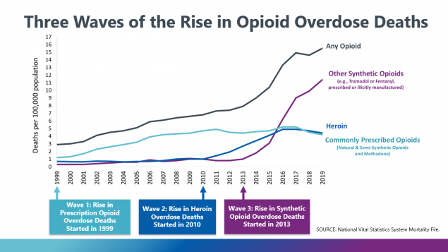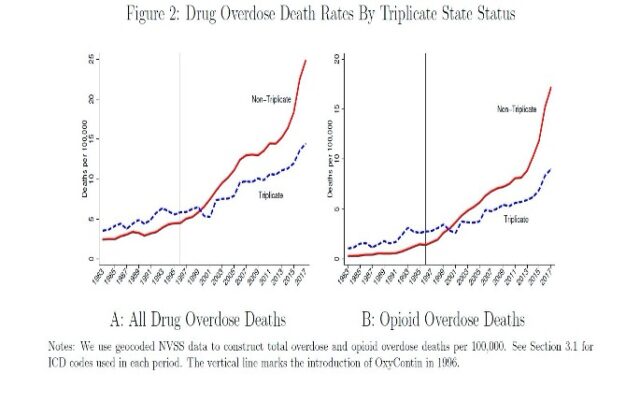Part 1: The Scope of Justice
Opioid addiction reaches across the country
Drug overdose deaths have quadrupled since 1999.1 The Center for Disease Control and Prevention ties the massive increase to the proliferation of prescription opioids in the 1990s.2 OxyContin, an opioid created by Purdue Pharmaceuticals, was the driver of the large increase in opioid use. After their aggressive marketing campaigns, use of opioids increased and overdose deaths increased steadily in the first decade of the 21st century. The makers of OxyContin, Purdue Pharmaceuticals, switched their formula in 2010 to make the drug harder to abuse.3 After 2010, death rates shot up as more people switched from using OxyContin to stronger drugs, like heroin and fentanyl. Numerous studies have tied Purdue’s reformulation to an increase in heroin use. In one such study, one third of those who struggled with addiction to the original OxyContin replaced it with other drugs after it was reformulated. The vast majority moved to heroin.4 According to a survey by Pew Research, 29% of Philadelphia residents know someone who has died because of opioids.5

Figure 1: Graph from the Centers for Disease Control and Prevention (CDC: https://www.cdc.gov/drugoverdose/epidemic/index.html)
There are more stories behind these numbers than any paper could contain, and death statistics only account for the most extreme cases. Countless other families have been impacted by the effects of addiction. In a 2018 Gallup Poll, 30% of Americans said that drug abuse was an issue in their families, and 47% said heroin was an issue in their communities.6 More in U.S. say illegal drugs are a more serious problem. 2017. For those who struggle with the disease, it can be the dominant force in their life. Journalist Masha Gessen, who has been covering the opioid crisis for the New Yorker for years, was prescribed painkillers after a surgery which they did not take.7 Gessen’s son, a college student, was also prescribed opioids after attempting to climb a wall and breaking his ankle in 2019. Gessen’s son went back to college after the injury, and a few months later was placed on medical leave. He had not been attending classes, and Gessen did not know why. Shortly after coming home, Gessen’s daughter found her brother nonresponsive. He had overdosed on OxyContin. Gessen wrote in the New Yorker this year that their son has since “got clean, relapsed, got clean again, relapsed again, flunked out of college, and destroyed his relationships with many of the people who love him, including me.” Even if he stays sober, Gessen reported that his life is forever altered by his addiction. “He has told me that not an hour of his life passes when he doesn’t think about opioids.”8
Five hours away, in Cape Cod, Massachusetts, so many parents have been lost to the opioid crisis that schools have specialized counselors to deal with addiction-related trauma.9 PBS’ Frontline has a section of its website dedicated to “Heroin & Opioid Addiction, In Your Own Words.” Kyle from Fort Worth, Texas wrote in: “the people that use it ain’t bad people, it’s just that the drug itself is bad. It’ll grab you and never let you go.” Pam from New Smyrna Beach, Florida said, “We are not bad people trying to be good. We are sick people trying to get well.” 10
As this crisis swept the country, it took from National Book Award-winning parents in New York and kids on Cape Cod. Its impact was harshly felt across the heartland and on the coasts. As the result of its broad impact, Pam and Kyle’s message has penetrated: America does not hold the victims responsible for their lot, as it has in previous drug crises. Most Americans now believe that opioid abusers should be met with treatment, not incarceration.11 Many understand that the prescription drug crisis was brought about by Purdue Pharmaceuticals, a closely held corporation held by the Sackler family. Their only motivation, and their only justification, was prescribed by the free-market bias in American law: the pursuit of profit.
The Identifiable Victim Effect
The dominant narrative in this case is distinct from other cases of drug abuse and drug addiction crises, which can be explained by both the specific reach of the problem, and cognitive biases.
Substance abuse has historically been criminalized in the United States, and previous drug epidemics have been defined by the media and in popular culture as caused not by systemic problems, but by the drug users’ dispositions. For example, during the crack cocaine crisis of the 1980s and 1990s, the government’s policy response was to criminalize Black and Latino drug users. Policymakers responded by cracking down on individuals rather than treating the crisis as a public health issue. The federal government passed laws that were not only tough on drug use, but they were also specifically aimed at drugs more commonly used by people of color. For example, until recently, possession of powder cocaine, which was more commonly used by white people, was only a federal offense if the person had 100 times more of the drug than a federal offender for crack cocaine. This law was passed despite the drugs sharing essentially the same chemical make-up. In the 1980s and 1990s mandatory minimums abounded, enforcement was unequal, and Black Americans are still 6-10 times more likely to be incarcerated for a drug offense despite using or abusing substances no more often than white Americans.12
These responses fall into the category of dispositionist thinking. Dispositionist thinking puts the onus on the individual, rather than the systems the individual lives in. The dominant narrative for the crack epidemic was that people were lazy, weak, or criminal, and needed to be responded to with harsh punishment on an individual level. Research in psychology has shown that when alleviating suffering would be difficult or complicated, people tend to justify the suffering to soothe the cognitive dissonance otherwise experienced.13 Because the world is unfair, the brain tends to justify the unfairness to ease the otherwise difficult thoughts. This cognitive distortion may explain some of the motivation behind the dominant narrative of the crack epidemic, which framed those struggling with addiction as criminals rather than seeing them as victims in need of assistance.
However, as the opioid epidemic swept through wealthier, whiter, and more educated communities, the narrative of drug addiction changed. The dominant story, as told by the media, policymakers, and popular culture, began to portray addiction as a disease. The blame shifted away from those using drugs, and towards those profiting from them. Substance abusers came to be seen as victims, and the corporate law mechanisms and greed that facilitated the epidemic came to light. Because the victims of the opioid crisis are whiter and wealthier than those affected by previous drug crises, those in power are more likely to know a victim. This brought an urgency to the crisis that was felt by the mid-2010s which led both politicians to act and journalists to cover the story.14 In order to see action on an issue in America, the victims need to fall within the scope of justice of those in power. The opioid crisis affected everyone because it was driven by boundless- and unregulated- greed.
Part 2: The Problem and The Profiteers
Selling Our Health to the Highest Bidder: Free Market Pharmaceuticals
The proliferation of prescription opioids in America can be tied to one company, owned by one family. The Sackler family, owners of Purdue Pharmaceuticals, made billions from the sales of Oxycontin, an opioid with powerful addictive properties like others before it which was sold to doctors as safe.
This is where corporate law, or the lack thereof, paved the way for a disaster. Purdue’s advertising claimed that OxyContin was not as addictive as other opioids, and that it would solve serious issues with pain across the country.15 Purdue’s marketing warned physicians of an “epidemic of pain,” and pitched OxyContin as the solution. Purdue told doctors that less than 1% of patients would become addicted to OxyContin and promoted the prescription of opioids for a long list of less serious conditions.



Testimonials from the advertising materials showed happy and pain-free patients working, exercising, and enjoying life. Several of the patients featured in the promotional materials later became addicted to OxyContin. Stills taken from Milwaukee Journal Sentinel’s retrospective on Purdue’s original marketing campaign. 16
Purdue also paid for messages promoting the idea that ibuprofen and acetaminophen, better known as Advil and Tylenol, were unsafe, but opioids are “the gold standard of pain medication.”17 Purdue’s funded messages, designed to look independent from Purdue, said that these common household pain relievers have “life-threatening side effects” if taken in high doses.18
This type of pharmaceutical marketing is a uniquely American phenomenon. The United States does not regulate drug prices, and American law governing drug marketing is highly permissive compared to other developed countries. This belief in the power of markets, even extended to healthcare, creates the incentive for pharmaceutical companies to run massive marketing campaigns targeting both consumers and physicians. The United States is one of only two countries which allows direct-to-consumer drug advertising{{See Do Not Get Sold on Drug Advertising, Harvard Men’s Health Watch. February, 2017. Available at: https://www.health.harvard.edu/drugs-and-medications/do-not-get-sold-on-drug-advertising
Keyhani, S., Wang, S., Hebert, P., Carpenter, D., & Anderson, G. (2010). US pharmaceutical innovation in an international context. American journal of public health, 100(6), 1075–1080. Available at: https://www.ncbi.nlm.nih.gov/pmc/articles/PMC2866602/ }}, but the majority of marketing spending promotes prescription drugs to the prescribers.19 U.S. preference for free markets puts even health in the hands of the highest bidder. Despite being 4% of the world’s population, 42% of global prescription drug spending takes place in the United States.20 The permissive marketing structure, combined with the permissive pricing structure, creates the incentive and opportunity for bad actors to downplay the negative effects of a new prescription drug. Other countries control drug prices, but the United States allows pharmaceutical companies to set their own.
Marketing made a difference
In this case, the American law’s standard permission slip for profit-motivated corporate activity led directly to the opioid crisis. The FDA Scientist who evaluated OxyContin, Curtis Wright, wrote in his initial review that “Care should be taken to limit competitive promotion.”21 Unfortunately, this recommendation was non-binding. American law has no such regulation of competitive drug marketing, and evidence suggests a direct link between the marketing of OxyContin and overdose rates today.
Regulation may have saved many lives. Prior to the introduction of OxyContin, some states had already suffered problems with prescription drug abuse. These states introduced regulations which monitored prescriptions, requiring physicians to alert the state when potentially addictive opioids were dispensed. The programs intended to make sure that patients did not receive multiple opioid prescriptions from multiple doctors. Today, many states have similar programs to attempt to control the flow of opioids to individuals.22 When Purdue began pushing OxyContin, the company evaluated these regulated states as less fertile markets for their drug. The regulations, designed to curb opioid abuse, were seen as an obstacle to profits from OxyContin prescriptions. Despite the company’s claims that the drug was safe, they viewed attempts to control this controlled substance as interfering with their ultimate purpose: profit.
As a result, the company invested less time and money in marketing to states with monitoring programs. An internal report noted that of physicians in states with these programs, “only a few would ever use the product, and for them it would be on a very infrequent basis.”23 Their internal report ultimately concluded that OxyContin “should only be positioned [marketed] to physicians in non-triplicate [regulated] states.” While the opioid crisis has since swept the entire country, these states have experienced significantly less growth in the overdose rate, even today.

Figure 2: Continuing effects of prescription regulations implemented in the 1990s. “Triplicate” states are states with monitoring regulations 24
Massachusetts was not regulated prior to the introduction of OxyContin, and Purdue’s marketing team targeted doctors in Boston, southeastern Massachusetts, and Cape Cod. Some doctors received daily visits from sales representatives. When Purdue caught that two doctors in Massachusetts were prescribing OxyContin inappropriately, they reported it to the board of the company- made up of many members of the Sackler family. The doctors had made Purdue $823,000 in two years, and the company did not immediately report their excesses to licensing officials.25
The Identifiable Villain Effect
Some corporate-caused crises get public relations benefits from complicated narratives. A faceless corporate entity pushing a product for the opaque master of shareholder profit through boring and confusing mechanisms is harder to hold accountable. The blame for the opioid crisis falls on specific actors: the Sackler family. The owners of Purdue Pharmaceuticals made over ten billion dollars from Oxycontin and continued pushing the drug well after the crisis was in full swing.26
This family’s greed created another narrative tool that contributed to the popular narrative of opioid addiction as a public health crisis created for profit. The Sacklers became a helpful foil to the identifiable victims: they were clearly identifiable villains. The public understanding could have been that the issue was an “act of God,” or a problem with many parents, like the COVID-19 Pandemic. However, the identification of particular “villains” who profited off the deaths of many while promoting their names on art museums and hospitals mobilized many to understand the people and profit motive behind this crisis.
Why did the press and prosecutors label the Sacklers as the villains in this story, while there are major profiteers behind several other crises who have gotten away with it? It can be partially explained by the scope of the crisis and the identity of the victims, which drew attention to the cause. The other explanation is that the Sacklers, if not uniquely culpable in the corporate world, uniquely profited from the suffering of others. Purdue Pharmaceuticals was a closely held company, which made the vast majority of its billions of dollars off the sales of OxyContin.27 The Sacklers’ had a strong hand in the management of the company and pushed both the marketing of the drug in the 1990s and its continued growth once its addictive properties were fully known to the company.
These details of the Sackler’s relentless pursuit of profit over public health outcomes came to light in lawsuits, but the family’s notoriety arose from the work of artist activists who sought to draw attention to the crisis and the family’s culpability. The Sacklers focused much of their philanthropy on financing museum and hospital wings with their names prominently displayed. Major museums including the Met in New York and Harvard’s Art Museum had wings or buildings named for the Sackler family. Artists affected by the opioid crisis drew attention the Sackler’s profiteering off others’ suffering and demanded that their name be taken off these cultural institutions. Nan Goldin, a photographer who struggles with opioid addiction, has led the movement to get the Sacklers’ names removed from museums and medical centers, using protest. Goldin hosted a “die-in” at the Guggenheim museum to highlight the human cost of the Sackler’s greed. She spread the message using hashtags like #ShameonSacklers. Goldin stated her aim in 2018 editorial for ArtForum: “To get their ear we will target their philanthropy,” Goldin wrote. “They have washed their blood money through the halls of museums and universities around the world.”28 The Sacklers, in their family group chat, told each other that Goldin was “crazy” and “pulling a stunt,” but several recipients of Sackler philanthropy pulled their names from buildings and institutes following her efforts.29
The Sacklers were personally involved in the marketing plan to push opioids as safe starting in 1995, and continued to aggressively market opioids even while paying out settlements to families harmed by opioids. In 1997, the Sacklers considered marketing OxyContin as a non-controlled substance to increase prescriptions in some countries. The inventor of the drug objected, writing in an email to Richard Sackler, “I don’t believe we have a sufficiently strong case to argue that OxyContin has minimal or no abuse liability… oxycodone containing products are still among the most abused opioids in the U.S.” Sackler ignored the risks and responded, “How substantially would it improve your sales?”30

The name “Sackler” is removed from a sign at Tufts University.31
Deep Capture and Coverups
It only took as long as it did for the Sacklers’ sins to come to light because of the intervention of very powerful people. In 2006, U.S. Attorneys working for the Department of Justice were prepared to prosecute Purdue Pharmaceuticals, the CEO, the company’s general counsel, and chief medical officer for the fraud perpetuated on the American public.32 According to the prosecution memo, a document prepared for the purpose of seeking approval from higher-ups to proceed with the indictment, Executives at Purdue Pharmaceutical were aware that the claims made in their 1990s marketing materials were false. The company was aware that OxyContin had addictive properties, and they lied to physicians in their marketing materials to encourage them to write prescriptions for it freely. The Sacklers blamed those who became addicted to the drug for their struggles. In an email to a friend in 2001, Richard Sackler wrote, “Abusers [of OxyContin] aren’t victims, they’re the victimizers.”33 In another email, he described this dispositionist attitude as a public relations strategy. “We have to hammer on the abusers in every way possible. They are the culprits and the problem. They are reckless criminals.”34
However, Purdue’s powerful attorneys- including Rudy Giuliani, former mayor of New York City- met with top officials at President Bush’s justice department, and the case was quashed. The attorneys were not permitted to proceed with the indictment, and instead, a guilty plea was negotiated for Purdue’s corporate entity. The executives pled to misdemeanors. Purdue pled guilty and paid $600 million dollar settlement- the equivalent of just six months of the company’s OxyContin revenue, a fraction of the company’s earnings.{{Meier, Barry. In Guilty Plea, OxyContin Maker to pay $600 Million. May 10, 2007. New York Times. Available at: https://www.nytimes.com/2007/05/10/business/11drug-web.html;
Patrick Radden Keefe, The Sackler Family’s Plan to Keep its Billions. October 4, 2020. The New Yorker. Available at: https://www.newyorker.com/news/news-desk/the-sackler-familys-plan-to-keep-its-billions}} The executives paid fines and the company continued using the marketing practices that led to the government investigation in the first place. The guilty plea was celebrated as a win, and the results of the investigation by the Department of Justice never saw the light of day. The New York Times only got a copy of the prosecution memo in 2019.35 Because influential people intervened, Purdue was let off the hook easy, and its executives were protected from the truth revelaled by the investigation. The fraudulent behavior was not made public, and the lawsuit did not come close to the ultimate beneficiaries of the behavior: the Sacklers.
Despite the company’s settlement with the Department of Justice in 2006, the Sacklers continued to make decisions based on profit rather than public health. In 2010, When executives reported a lower predicted growth for OxyContin sales than the Sacklers wanted, Richard Sackler responded, “I’m disappointed and don’t agree with you. This is a matter that the Board will have to take up and give you a settled direction.” 36 Richard and Mortimer Sackler discussed the issue and encouraged management to push the drug to more prescribers. Sales declined anyway. According to Purdue’s internal studies, this was due to a decrease in medically unnecessary prescriptions.37 The company was aware of problematic prescribers who doled out more than recommended amounts of OxyContin, and these doctors were the source of much of the decline. The Sacklers were made aware of these findings by December 1, 2010.38 After expressing concern over the declining sales, regardless of the public health reasons behind them, Mortimer Sackler recommended searching for a new CEO and replacing the head of sales and marketing.39
After decades of pain and effort, Purdue Pharmaceuticals has declared bankruptcy in the face of thousands of lawsuits. The Sackler family is still being sued personally by the Massachusetts Attorney General’s Office, among others. Purdue Pharmaceuticals and the Sacklers settled several lawsuits from the federal government and several states for over 8 billion dollars.40
Conclusion
No Justice, but a Path Forward
Purdue did not have appropriate incentives to look out for the addiction crisis they caused, and indeed demonstrated inhuman unfeeling towards it when they aimed to continue marketing OxyContin despite its known risks. Drug marketing should be tightly regulated in America, as it is internationally. No doctor should get visits every day from a pharmaceutical representative, as some did in Massachusetts. Further, the profit motive in healthcare must be carefully studied and hemmed in where it leads to excesses. Drug pricing may not need to be regulated exactly as it is abroad, as pharmaceutical prices in the United States may be important to incentivizing the development of new drugs.41 However, the current regulatory framework treats healthcare companies far too similarly to companies selling consumer goods. Healthcare has never been a real “market”, as any American turned away from a doctor’s office for lack of insurance coverage can tell you. The incentives are not balanced between a seller and customer, who can walk away or shop elsewhere, in the classic economic model. Rather, decisions are made between a patient with limited information and her doctor, her insurance company, her pharmacist, her government, pharmaceutical companies, and the shareholders of those pharmaceutical companies. The stakes are not whether to purchase a new pair of pants, they are life and death. America has decided some things are too important to commodify and treated them as public goods, regulated separately from the market. Healthcare should be added to that list.
Further, America should be cautious to not fall into the same cognitive traps that produced unfeeling criminalization of previous drug crises when planning for opioid addiction treatment. The path forward for those in the grips of the opioid crisis may require some new thinking on the part of policymakers. Two successful harm-reduction strategies, medication-assisted treatment and supervised injection sites, face opposition because of moralizing attitudes towards drug users. Despite being highly successful at helping those with addiction get back to their normal lives, medication-assisted treatment programs for addiction are hard to access because of dispositional thinking about keeping those who have experienced addiction away from any kind of drug. Supervised injection sites, while proven to reduce deaths, have yet to be established in the United States because of similar concerns about “condoning” drug use, even by those who are already using.42 Finally, profit motives have followed the crisis even into treatment for addiction. Kathe Sackler suggested getting into the business of Suboxone, a drug that treats addiction, to continue profiting off those drawn into the cycle- further evidence that healthcare should be kept far from the incentives of corporate law.43
With so many lives lost and altered, it is hard to know what justice would look like in the wake of the pain caused by Purdue. Even if the Sacklers were incarcerated and forced to return all of the billions of dollars they earned, it would not cure addiction for those suffering from it or undue the deaths from overdoses. What could be fixed is the incentives for pharmaceutical companies and others to prioritize human health over profit, and the cognitive traps that produce those conditions.
Further Reading
Patrick Radden Keefe, Empire of Pain, 2021.
Beth Macy, Dopesick, 2018.
